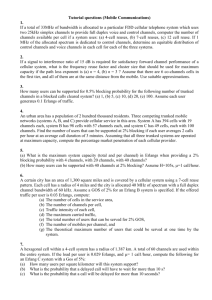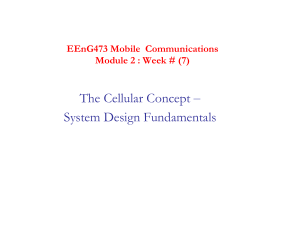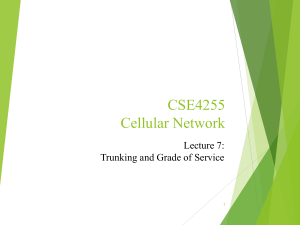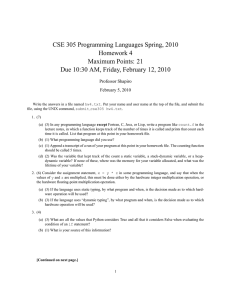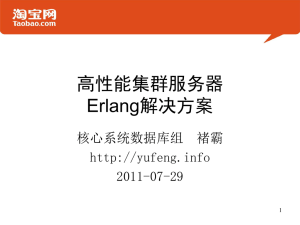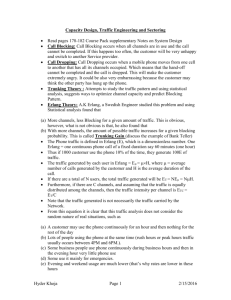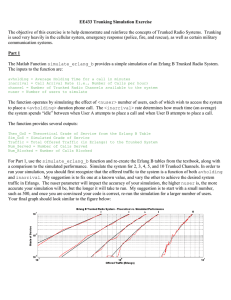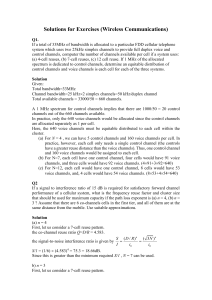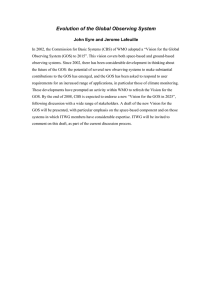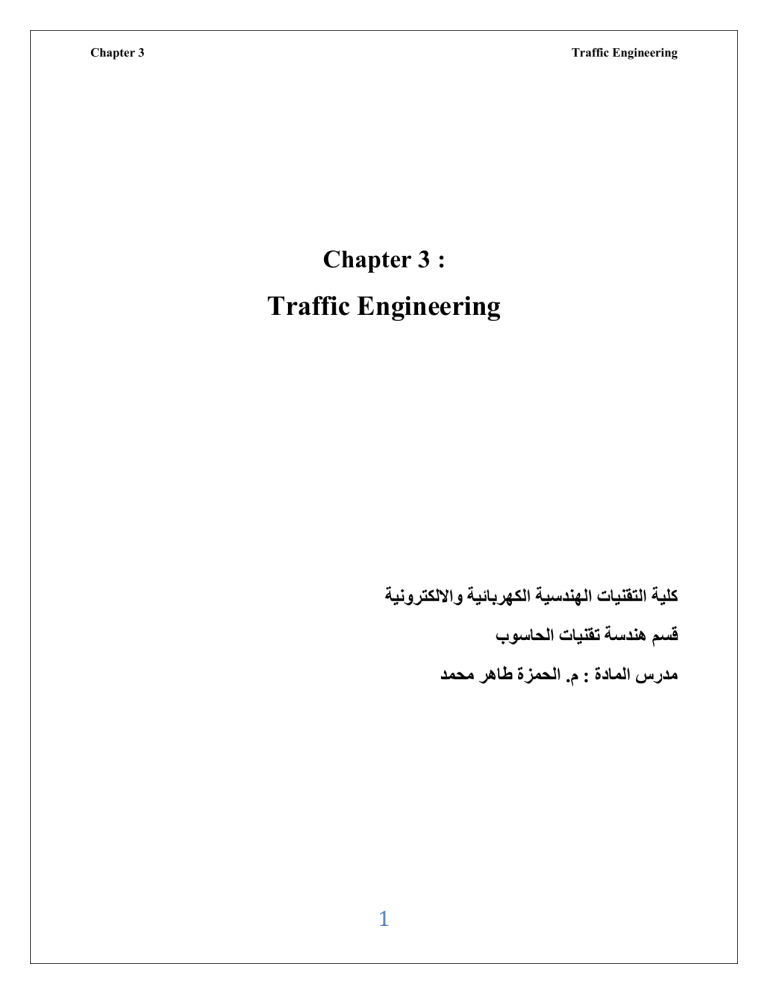
Chapter 3 Traffic Engineering Chapter 3 : Traffic Engineering كلية التقنيات الهندسية الكهربائية وااللكترونية قسم هندسة تقنيات الحاسوب مدرس المادة :م .الحمزة طاهر محمد 1 Chapter 3 Traffic Engineering Chapter 3 3.1 Trunking and Grade of Service A- Trunking The number of trunks connecting the MSC A with another MSC B are the number of voice pairs used in the connection. One of the most important steps in telecommunication engineering is to determine the number of trunks required on a route or a connection between MSCs. To dimension a route correctly, we must have some idea of its usage, that is, how many subscribers are expected to talk at one time over the route. The concept of trunking allows a large number of users to share the relatively small number of channels in a cell by providing access to each user, on demand, from the available channels. In a trunked radio system, each user is allocated a channel on a per call basis, and upon termination of the call, the previously occupied channel is immediately returned to the pool of available channels. The telephone company uses trunking theory to determine the number of telephone circuits that need to be allocated and this same principle is used in designing cellular radio systems. As the number of phone lines decreases, it becomes more likely that all circuits will be busy for a particular user. In a trunked mobile radio system, When a particular user requests service and all of the radio channels are already in use, the user is blocked, or denied access to the system. In some systems, a queue may be used to hold the requesting users until a channel becomes available. To design trunked radio systems that can handle a specific capacity at a specific "grade of service", it is essential to understand trunking theory and queuing theory. The fundamentals of trunking theory were developed by Erlang, a Danish who, in the late 19th century. One Erlang represents the amount of traffic intensity carried by a channel that is completely occupied (i.e. 1 call-hour per hour or 1 call-minute per minute). Traffic is measured in either: - Erlangs, - Percentage of occupancy, - Centrum (100) call seconds (CCS), 2 Chapter 3 Traffic Engineering B- The grade of service (GOS): is a measure of the ability of a user to access a trunked system during the busiest hour. The grade of service is a benchmark used to define the desired performance of a particular trunked system by specifying a desired probability of a user obtaining channel access given a specific number of channels available in the system. It is the wireless designer's job to estimate the maximum required capacity and to allocate the proper number of channels in order to meet the GOS. GOS is typically given as the probability that a call is blocked, or the probability of a call experiencing a delay greater than a certain queuing time. Traffic intensity is the average number of calls simultaneously in progress during a particular period of time. It is measured either in units of Erlangs or CCS. The traffic intensity offered by each user is equal to the call request rate multiplied by the holding time (in hours). That is, each user generates a traffic intensity of AU Erlangs given by AU H where H is the average duration of a call (Holding time). λ is the average number of call requests per unit time. For a system containing U users and an unspecified number of channels, the total offered traffic intensity A, is given as A UAU And Overflow (O)= (Offered load) – (Carried load) CCS to Erlang conversion An average of one call in progress during an hour represents a traffic intensity of 1 Erlang; thus 1 Erlang equals 1 × 3600 call seconds (36 CCS). The Erlang is a dimensionless number. 3 Chapter 3 Traffic Engineering Example 1 If the carried load for a component is 3000 CCS at 5% blocking, what is the offered load? Solution Offered load 3000 3158CCS (1 0.05) Overflow = (Offered load) – (Carried load) = 3158 – 3000 = 158 CCS Example 2 In a wireless network each subscriber generates two calls per hour on the average and a typical call holding time is 120 seconds. What is the traffic intensity? Solution Au H 2 120 0.0667 Erlangs 2.4 CCS 3600 Example 3 In order to determine voice traffic on a line, we collected the following data during a period of 90 minutes. Calculate the traffic intensity in Erlangs and CCS. 4 Chapter 3 Traffic Engineering Solution 10 6.667 calls / hour 1.5 Average call holding time: H (60 74 80 90 92 70 96 48 64 126) 80 sec/call 10 Au H 6.667 80 0.148 Erlangs 5.33CCS 3600 Example 4 We record data in the Table below by observing the activity of a single customer line during an eight-hour period from 9:00 A.M. to 5:00 P.M. Find the traffic intensity during the eighthour period, and during busy hour (BH) which occurs between 4:00 P.M. and 5:00 P.M. Solution 11 1.375calls / hour 8 Total call minutes = 3 + 10 + 7 + 10 + 5 + 5 + 1 + 5 + 15 + 34 + 5 = 100 minutes The average holding time in hours per call is: 5 Chapter 3 H Traffic Engineering 100 1 0.1515hours / call 11 60 The traffic intensity is A H 1.375 0.1515 0.208 Erlangs 7.5 CCS The busy hour (BH) is between 4:00 P.M. and 5:00 P.M. Since there are only two calls between this period, we can write: Call arrival rate = 2 calls/hour The average call holding time during BH: H 34 5 19.5 min/ call 0.325 hours / call 2 The traffic intensity during BH is A H 2 0.325 0.65 Erlangs 23.4 CCS Example 5 The average mobile user has 500 minutes of use per month; 90% of traffic occurs during work days (i.e., only 10% of traffic occurs on weekends). There are 20 work days per month. Assuming that in a given day, 10% of traffic occurs during the BH, determine the traffic per subscriber per BH in Erlangs. Solution Average busy hour usage per subscriber = (minutes of use/month) × (fraction during work ( Percentagein busy hour) day) × Work days / month Average busy hour usage per subscriber = 500 × 0.9 × 0.1/20 = 2.25 minutes of use per subscriber per busy hour. Au = 2.25/60 = 0.0375 Erlangs 6 Chapter 3 Traffic Engineering Example 6 If the mean holding time in Example 5 is 100 seconds, find the average number of busy hour call attempts (BHCAs). Solution Au = 0.0375 Erlangs = 135 call/sec BH Au 1.35 100 In a C channel trunked system, if the traffic is equally distributed among the channels, then the traffic intensity per channel, Ac, is given as AC UAU C When the offered traffic exceeds the maximum capacity of the system, the carried traffic becomes limited due to the limited capacity (i.e. limited number of channels). The maximum possible carried traffic is the total number of channels, C, in Erlangs. The AMPS cellular system is designed for a GOS of 2% blocking. This implies that the channel allocations for cell sites are designed so that 2 out of 100 calls will be blocked due to channel occupancy during the busiest hour. There are two types of trunked systems which are commonly used. 1- no queuing 2- queuing (1) The first type offers no queuing for call requests. That is, for every user who requests service, it is assumed there is no setup time and the user is given immediate access to a channel if one is available. If no channels are available, the requesting user is blocked without access and is free to try again later. This type of trunking is called blocked calls cleared and assumes that calls arrive as determined by a Poisson distribution. Furthermore, it is assumed that there are an infinite number of users as well as the following: (a) there are memoryless arrivals of requests, implying that all users, including blocked users, may request a channel at any time; 7 Chapter 3 Traffic Engineering (b) the probability of a user occupying a channel is exponentially distributed, so that longer calls are less likely to occur as described by an exponential distribution; (c) There are a finite number of channels available in the trunking pool. This is known as an M/M/m queue, and leads to the derivation of the Erlang B formula (also known as the blocked calls cleared formula). The Erlang B formula determines the probability that a call is blocked and is a measure of the GOS for a trunked system which provides no queuing for blocked calls. The Erlang B formula is given by AC Pr [blocking] C C! k GOS A k 0 k! where C is the number of trunked channels offered by a trunked radio system and A is the total offered traffic. While it is possible to model trunked systems with finite users, the resulting expressions are much more complicated than the Erlang B result, and the added complexity is not warranted for typical trunked systems which have users that outnumber available channels by orders of magnitude. Furthermore, the Erlang B formula provides a conservative estimate of the GOS, as the finite user results always predict a smaller likelihood of blocking. The capacity of a trunked radio system where blocked calls are lost is tabulated for various values of GOS and numbers of channels in Table below Capacity of an Erlang B system Number of channels C 2 4 5 10 20 24 40 70 100 Capacity (Erlangs) for GOS 0.01 0.005 0.002 0.001 0.153 0.105 0.065 0.046 0.869 0.701 0.535 0.439 1.36 1.13 0.9 0.762 4.46 3.96 3.43 3.09 12 11.1 10.1 9.41 15.3 14.2 13 12.2 29 27.3 25.7 24.5 56.1 53.7 51 49.2 84.1 80.9 77.4 75.2 8 Chapter 3 Traffic Engineering (2) The second kind of trunked system is one in which a queue is provided to hold calls which are blocked. If a channel is not available immediately, the call request may be delayed until a channel becomes available. This type of trunking is called Blocked Calls Delayed, and its measure of GOS is defined as the probability that a call is blocked after waiting a specific length of time in the queue. To find the GOS, it is first necessary to find the likelihood that a call is initially denied access to the system. The likelihood of a call not having immediate access to a channel is determined by the Erlang C formula Pr [delay 0] AC k A C 1 A AC C!1 C k 0 k! If no channels are immediately available the call is delayed, and the probability that the delayed call is forced to wait more than t seconds is given by the probability that a call is delayed, multiplied by the conditional probability that the delay is greater than t seconds. The GOS of a trunked system where blocked calls are delayed is hence given by Pr [delay t ] Pr [delay 0] Pr [delay t | delay 0] Pr [delay 0] exp (C A)t / H The average delay D for all calls in a queued system is given by D Pr [delay 0] H CA where the average delay for those calls which are queued is given by H/(C-A). The Erlang B and Erlang C formulas are plotted in graphical form in the two Figures below. These graphs are useful for determining GOS in rapid fashion, although computer simulations are often used to determine transient behaviors experienced by particular users in a mobile system. 9 Chapter 3 Traffic Engineering To use the two figures: a. Locate the number of channels on the top portion of the graph. b. Locate the traffic intensity of the system on the bottom portion of the graph. c. The blocking probability Pr[blocking] is shown on the abscissa of the first Figure, and Pr[delay > 0] is shown on the abscissa of the second Figure. With two of the parameters specified it is easy to find the third parameter. 10 Chapter 3 Traffic Engineering Example 1 How many users can be supported for 0.5% blocking probability for the following number of trunked channels in a blocked calls cleared system? a. 5 b. 10 Assume each user generates AU = 0.1 Erlangs of traffic. Solution (a) From Erlang B chart, we obtain A ≈ 1 Therefore, total number of users, U = A/AU = 1 /0.1 = 10 users. (b) From Erlang B chart, we obtain A ≈ 4 Therefore, total number of users, U = A/AU = 4 /0.1 = 40 users. --------------------------------------------------------------------------------------------------------------Example 2 How many users can be supported for 0.5% blocking probability for the following number of trunked channels in a blocked calls cleared system? (a) 1, (b) 5, (c) 10, (d) 20, and (e) 100. Assume each user generates 0.1 Erlangs of traffic. Solution From the table of the capacity of an Erlang B system, we can find the total capacity in Erlangs for the 0.5% GOS for different numbers of channels. By using the relation A = UAU, we can obtain the total number of users that can be supported in the system. (a) Given C = 1, AU = 0.1, GOS = 0.005 From Erlang B chart, we obtain A = 0.005 Therefore, total number of users, U = A/AU = 0.005 /0.1 = 0.05 users. But, actually one user could be supported on one channel. So, U = 1 (b) Given C = 5, AU = 0.1, GOS = 0.005 From Erlang B chart, we obtain A = 1.13 Therefore, total number of users, U = A/AU = 1.13/0.1 = 11 users. (c) Given C = 10, AU = 0.1, GOS = 0.005 11 Chapter 3 Traffic Engineering From Erlang B chart, we obtain A = 3.96 Erlangs Therefore, total number of users, U = A/AU = 3.96/0.1 ≈ 39 users. (d) Given C = 20, AU = 0.1, GOS = 0.005 From Erlang B chart, we obtain A = 11.10 Therefore, total number of users, U = A/AU = 11.1/0.1 = 110 users. (e) Given C = 100, AU = 0.1, GOS = 0.005 From Erlang B chart, we obtain A = 80.9 Therefore, total number of users, U = A/AU = 80.9/0.1 = 809 users. -------------------------------------------------------------------------------------------------------------- 3.2 Trunking efficiency It’s a measure of the number of users which can be offered a particular GOS with a particular configuration of fixed channels. The way in which channels are grouped can substantially alter the number of users handled by a trunked system. For example, from the table of the capacity of an Erlang B system, 10 trunked channels at a GOS of 0.01 can support 4.46 Erlangs of traffic, whereas 2 groups of 5 trunked channels can support 2×1.36 Erlangs, or 2.72 Erlangs of traffic. Clearly, 10 channels trunked together support 60% more traffic at a specific GOS than do two 5 channel trunks! It should be clear that the allocation of channels in a trunked radio system has a major impact on overall system capacity. 3.3 Improving Capacity in Cellular Systems As the demand for wireless service increases, the number of channels assigned to a cell eventually becomes insufficient to support the required number of users. At this point, cellular design techniques are needed to provide more channels per unit coverage area. Techniques such as cell splitting and sectoring approaches are used in practice to expand the capacity of cellular systems. 12 Chapter 3 Traffic Engineering 3.3.1 Cell Splitting It is the process of subdividing a congested cell into smaller cells, each with its own base station and a corresponding reduction in antenna height and transmitter power. Cell splitting increases the capacity of a cellular system since it increases the number of times that channels are reused. By defining new cells which have a smaller radius than the original cells and by installing these smaller cells (called microcells) between the existing cells, capacity increases due to the additional number of channels per unit area. Imagine if every cell in the Figure below were reduced in such a way that the radius of every cell was cut in half. In order to cover the entire service area with smaller cells, approximately four times as many cells would be required. This can be easily shown by considering a circle with radius R. The area covered by such a circle is four times as large as the area covered by a circle with radius R/2. The increased number of cells would increase the number of clusters over the coverage region, which in turn would increase the number of channels, and thus capacity, in the coverage area. Cell splitting allows a system to grow by replacing large cells with smaller cells, while not upsetting the channel allocation scheme required to maintain the minimum cochannel reuse ratio between co-channel cells. 13 Chapter 3 Traffic Engineering Example of cell splitting: is shown in the Figure below. The base stations are placed at corners of the cells, and the area served by base station A is assumed to be saturated with traffic (i.e., the blocking of base station A exceeds acceptable rates). New base stations are therefore needed in the region to increase the number of channels in the area and to reduce the area served by the single base station. Note in the figure that the original base station A has been surrounded by six new microcell base stations. In the example shown in Figure, the smaller cells were added in such a way as to preserve the frequency reuse plan of the system. For example, the microcell base station labeled G was placed half way between two larger stations utilizing the same channel set G. This is also the case for the other microcells in the figure. As can be seen from Figure, cell splitting merely scales the geometry of the cluster. In this case, the radius of each new microcell is half that of the original cell. For the new cells to be smaller in size, the transmit power of these cells must be reduced. The transmit power of the new cells with radius half that of the original cells can be found by examining the received power Pr at the new and old cell boundaries and setting them equal to each other. This is necessary to ensure that the frequency reuse plan for the new microcells behaves exactly as for the original cells. Pr at old cell boundry Pt1Rn and R Pr at newcell boundry Pt 2 2 n where Ptl an Pt2 are the transmit powers of the larger and smaller cell base stations, respectively, n is the path loss exponent. If we take n = 4 and set the received powers equal to each other, then 14 Chapter 3 Traffic Engineering Pt 2 Pt1 16 In other words, the transmit power must be reduced by 12 dB in order to fill in the original coverage area with microcells, while maintaining the S/I requirement. In practice, not all cells are split at the same time. It is often difficult for service providers to find real estate that is perfectly situated for cell splitting. Therefore, different cell sizes will exist simultaneously. In such situations, special care needs to be taken to keep the distance between co-channel cells at the required minimum, and hence channel assignments become more complicated. Handoff issues must be addressed so that high speed and low speed traffic can be simultaneously accommodated (the umbrella cell approach is commonly used). When there are two cell sizes in the same region, the last equation shows that one cannot simply use the original transmit power for all new cells or the new transmit power for all the original cells. a. If the larger transmit power is used for all cells, some channels used by the smaller cells would not be sufficiently separated from co-channel cells. b. If the smaller transmit power is used for all the cells, there would be parts of the larger cells left unserved. For this reason, channels in the old cell must be broken down into two channel groups, one that corresponds to the smaller cell reuse requirements and the other that corresponds to the larger cell reuse requirements. The larger cell is usually dedicated to high speed traffic so that handoffs occur less frequently. 3.3.2 Sectoring Cell splitting achieves capacity improvement by essentially rescaling the system. By decreasing the cell radius R and keeping the co-channel reuse ratio D/R unchanged, cell splitting increases the number of channels per unit area. Another way to increase capacity is to keep the cell radius unchanged and seek methods to decrease the D/R ratio. In this approach, capacity improvement is achieved by reducing the number of cells in a cluster and thus increasing the frequency reuse. In order to do this, it is necessary to reduce the relative interference without decreasing the transmit power. The co-channel interference in a cellular system may be decreased by replacing a single omnidirectional antenna at the base station by several directional antennas, each radiating within a specified sector. 15 Chapter 3 Traffic Engineering By using directional antennas, a given cell will receive interference and transmit with only a fraction of the available co-channel cells. The technique for decreasing co-channel interference and thus increasing system capacity by using directional antennas is called sectoring. The factor by which the co-channel interference is reduced depends on the amount of sectoring used. A cell is normally partitioned into three 120° sectors or six 60° sectors as shown in Figures below. When sectoring is employed, the channels used in a particular cell are broken down into sectored groups and are used only within a particular sector. Assuming 7-cell reuse, for the case of 120° sectors, the number of interferers in the first tier is reduced from 6 to 2. This is because only 2 of the 6 co-channel cells receive interference with a particular sectored channel group. Referring to Figure (right), consider the interference experienced by a mobile located in the right-most sector in the center cell labeled "5". There are 3 co-channel cell sectors labeled "5" to the right of the center cell, and 3 to the left of the center cell. Out of these 6 co-channel cells, only 2 cells have sectors with antenna patterns which radiate into the center cell, and hence a mobile in the center cell will experience interference on the forward link from only these two sectors. The resulting S/I for this case can be found to be 24.2 dB, which is a significant improvement over the omni-directional case, where the worst case S/I was shown to be 17 dB. In practical systems, further improvement in S/I is achieved by downtilting the sector antennas such that the radiation pattern in the vertical (elevation) plane has a notch at the nearest co-channel cell distance. The improvement in S/I implies that with 120° sectoring, the minimum required S/I of 18 dB can be easily achieved with 7-cell reuse, as compared to 12-cell reuse for the worst possible situation in the unsectored case. Thus, sectoring reduces interference, which amounts to an increase in capacity by a factor of 12/7, or 1.714. 16 Chapter 3 Traffic Engineering In practice, the reduction in interference offered by sectoring enable planners to reduce the cluster size N, and provides an additional degree of freedom in assigning channels. The penalty for improved S/I and the resulting capacity improvement is an increased number of antennas at each base station, and a decrease in trunking efficiency due to channel sectoring at the base station. 17
